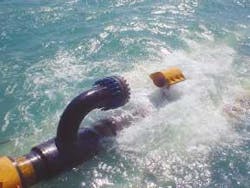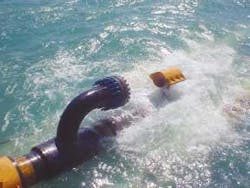Subsea/Surface Systems
William Furlow • Houston
Norway weighs subsea to beach
At the recent Intsok conference held in Houston, discussion centered around the Snøhvit subsea-to-beach development. Experts representing different aspects of this ambitious project outlined the technical challenges faced with piping production 125 mi from seabed completions to a shore-based facility.
Snøhvit is located in the Barents Sea 136 mi off the Norwegian coast in 350 m of water. Phase one of this development will include nine production wells and one CO2 injection well from Snøhvit and the nearby Albatross field. These will be produced through three of the four slots on three of the four subsea templates.
One slot on the fourth template will support the gas injection well. The other slots will come on line during the future development of the Askeladd field. Each of the four templates will be tied back to a pipeline end manifold via a 14-in. flowline. There will be a second dedicated PLEM for the future development of the Askeladd field.
Gas will be transported back to shore via a dedicated 36-in. 160-km flowline. The export line and subsea production equipment are sized for a maximum daily production of 735 MMscf/d to match the capacity of the onshore LNG plant. There will also be a dedicated 8-in. flowline to feed the injection well.
The control system uses a hybrid electrical and optical communication system. Electrical and hydraulic power is used to control the subsea facilities via a main umbilical. This 144-km umbilical terminates at a subsea central distribution unit from which power and communications are distributed to the templates using infield umbilicals. The control system is designed to add on new wells in the templates and can handle a maximum of 25 wells. They are also designed to incorporate future intelligent completion applications.
This control system is responsible for controlling and monitoring all of the subsea facilities. The biggest challenge in designing the umbilical is its length.
Rolf Nordauney, system department manager for ABB Offshore Systems Subsea Division, said the umbilical was constructed in a single length and has a depth capacity of 440 m. It is comprised on electrical, chemical, optical, and hydraulic lines.
Because the control system is responsible for the control of all tree and choke bridge valves as well as monitoring the instrumentation on these facilities, downtime must be minimized.
The choke bridge is located between the Christmas tree and the manifold, on each well. This single module can easily be pulled and replaced if it fails. A backup intervention control system will be used to replace the main umbilical in the event of total umbilical failure. This system can be stored on a reel and transported by a service vessel for installation in the event of a failure.
Early in this program, summer 2001, ABB and Statoil started a qualification program of the main technical elements for the control system. The purpose was to test critical components prior to contract award. The program gave the team a real head start, according to Nordauney. All control components, including the wet gas meter, were tested and qualified before the contract was let.
Global pens Pemex pipe projects
Global Industries has received several pipelay contracts from Mexican operator Pemex E&P. The company has contracted GI subsidiary Global Offshore Mexico to install 29 km of 24-in. pipeline from Enlace to Uech A in the Gulf of Mexico's Bay of Campeche.
The project calls for the installation of the pipeline, three risers, three expansion loops, and the subsea tie-in. Global will also perform trenching, five crossings, as well as hydrotesting of the pipeline, and topside work. The Titan 2, Cherokee, and Ingeniero II will execute the project.
null
Global Offshore Mexico will also install pipelines on the Akal-MB in the Bay of Campeche's Cantarell Field. The Akal-MB project, valued at approximately $40-million, includes the installation of two 24-in. oil and gas pipelines, one from Akal-MB to Akal-B and the other from Akal-MB to Akal-M. The project also requires installation of a 12-in. gas pipeline from ABN to Akal-MB.
The Shawnee will install the pipelines and the Titan 2 will perform the hook-up activities for the project scheduled later this spring.
Finally, Pemex has contracted Global Off-shore Mexico to install three 20-in. pipelines and nine 12-in. pipelines as part of the EPC-77 Project in the Cantarell Field. This project is valued at approximately $100 million and scheduled to be completed by the end of the first quarter 2005. The project will use Global's Hercules, Shawnee, and Pioneer vessels.
Composite drillable drive shoe applied offshore Borneo
BJ Tubular Services recently completed a contract for pile-driving services on Murphy Sarawak Oil Co.'s jackup-deployed platform off the west coast of Borneo. BJ said the project proved to be an engineering and operational challenge.
The four-structure support piles, measuring 36 in. by 1.25 in., would also be used as conductors for the Production A platform in West Patricia Field. Each of the four structure piles, or conductors, were to contain three 13-3/8-in. casing strings, using AB- STL flush connections, depending on pipe weight. This configuration would serve as the basis of a 12-well platform. The four piles were made up using internally-externally flush Oil States Puma connections.
Murphy Oil Engineering determined that the required penetration of the 36-in. piles would be 72 to 75 m below mudline.
Using soil data provided and drive simulations, BJ proposed to use a reduced ID drive shoe to lower the potential for washing out the casing during driving to reach the required pile penetration. This type of drive shoe is normally constructed from steel and remains inside the tip of the pile after it is successfully driven into place. However, due to the risk of connection interference and/or hang-up at the pile tip, Murphy Sarawak wanted a drillable drive shoe to avoid a permanent reduction in pile I.D.
As an alternative to conventional approaches, BJ proposed using an insert made of material other than steel that would perform the same function as a traditional drive shoe, but could be removed after pile driving was completed. Called the Composite Drillable Drive Shoe system (CDDS), this approach would mitigate internal pile skin friction while driving and allow installation to be achieved with currently available equipment.
The approach involved removing the insert after pile driving had been completed during the first pass of drill bit, while the combined structure pile/conductor string was cleaned out to a point located just past the shoe. A watermelon mill was located above the bit and set to the ID of the pipe at 33.5-in. By doing so, the tip of the conductor/structure pipe size is returned to the size of the parent bore. Drilling forward then began for the three 13 3/8-in. casing strings, and was successfully completed on schedule.

